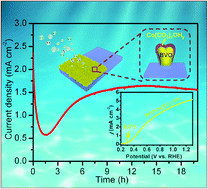当前位置:
X-MOL 学术
›
J. Mater. Chem. A
›
论文详情
Our official English website, www.x-mol.net, welcomes your
feedback! (Note: you will need to create a separate account there.)
Novel highly active and self-healing Co(CO3)xOHy cocatalysts on BiVO4 photoanodes for effective solar water oxidation
Journal of Materials Chemistry A ( IF 10.7 ) Pub Date : 2020/01/06 , DOI: 10.1039/c9ta13122a Lijun Wu 1, 2, 3, 4, 5 , Lei Wang 1, 2, 3, 4, 5 , Jie Zhu 1, 2, 3, 4, 5 , Mao Sun 1, 2, 3, 4, 5 , Xianhu Liu 5, 6, 7, 8, 9 , Patrik Schmuki 10, 11, 12, 13, 14 , Jun Zhang 1, 2, 3, 4, 5
Journal of Materials Chemistry A ( IF 10.7 ) Pub Date : 2020/01/06 , DOI: 10.1039/c9ta13122a Lijun Wu 1, 2, 3, 4, 5 , Lei Wang 1, 2, 3, 4, 5 , Jie Zhu 1, 2, 3, 4, 5 , Mao Sun 1, 2, 3, 4, 5 , Xianhu Liu 5, 6, 7, 8, 9 , Patrik Schmuki 10, 11, 12, 13, 14 , Jun Zhang 1, 2, 3, 4, 5
Affiliation

|
Recent reports show that Co-Pi cocatalysts on some photoanodes, such as Fe2O3 or BiVO4, accelerate the surface water oxidation rate, acting as a hole extracting layer that improves charge separation or as a “surface passivation agent”. In contrast, on semiconductors such as BiVO4, deposition of classic Co-based oxygen evolution catalysts (e.g. Co3O4, CoOOH) leads to a relatively low improvement of the photoelectrochemical (PEC) performance. This illustrates that even though a species may be an excellent electrocatalyst, it may not be an effective co-catalyst for PEC reactions. Clearly, for different semiconductors there is a need to directly identify and prepare specific, highly active and low-cost cocatalysts for promoting PEC water oxidation. Co(CO3)0.5(OH)·0.11H2O (or in general Co(CO3)xOHy) is usually used as a precursor to synthesize a range of Co-based efficient electrocatalysts. Herein, we for the first time show that Co(CO3)xOHy on BiVO4 provides an excellent oxygen evolution reaction activity, even close to the so far most efficient dual-layer FeOOH/NiOOH cocatalysts. Decoration of BiVO4 with Co(CO3)xOHy and the resulting photoanode shows a remarkable enhancement of photocurrent, achieving a photocurrent density of 5.0 mA cm−2 at 1.23 VRHE with an onset potential of 0.3 VRHE, which is one of the highest PEC activities of BiVO4 reported up to now. The outstanding PEC performance can be attributed to the improvement of charge separation and transfer efficiency caused by a uniform thin coating of Co(CO3)xOHy. The Co(CO3)xOHy exhibits the highest density of active sites, the highest surface area, and the best OER activity among the investigated cobalt-based cocatalysts. Remarkably, the Co(CO3)xOHy also displays a self-healing function in borate buffered electrolytes. Therefore, this work not only describes low-cost but highly active cobalt-based catalysts for PEC solar water oxidation, but additionally shows a self-repair function of this system.
中文翻译:

在BiVO4光阳极上的新型高活性和自修复Co(CO3)xOHy助催化剂可有效地氧化太阳能
最近的报告表明,某些光阳极(例如Fe 2 O 3或BiVO 4)上的Co-Pi助催化剂可加速表面水的氧化速率,充当改善电荷分离的空穴提取层或充当“表面钝化剂”。相反,在BiVO 4等半导体上,经典的Co基氧析出催化剂(例如Co 3 O 4,例如,CoOOH)导致光电化学(PEC)性能的改善相对较低。这说明即使一种物质可能是极好的电催化剂,也可能不是PEC反应的有效助催化剂。显然,对于不同的半导体,需要直接鉴定和制备特定的,高活性和低成本的助催化剂来促进PEC水的氧化。Co(CO 3)0.5(OH)·0.11H 2 O(或者通常是Co(CO 3)x OH y)通常用作合成一系列Co基高效电催化剂的前体。在这里,我们第一次显示了BiVO上的Co(CO 3)x OH y图4提供了优异的氧释放反应活性,甚至接近迄今为止最有效的双层FeOOH / NiOOH助催化剂。用Co(CO 3) x OH y装饰BiVO 4以及所得的光电阳极显示出显着的光电流增强,在1.23 V RHE时实现了5.0 mA cm -2的光电流密度,起始电位为0.3 V RHE,即到目前为止,BiVO 4的最高PEC活性报告。出色的PEC性能可归因于Co(CO 3) x均匀薄涂层导致的电荷分离和转移效率的提高OH ÿ。在所研究的钴基助催化剂中,Co(CO 3)x OH y表现出最高的活性中心密度,最高的表面积和最佳的OER活性。值得注意的是,Co(CO 3)x OH y在硼酸盐缓冲电解质中也显示出自愈功能。因此,这项工作不仅描述了用于PEC太阳能氧化的低成本,高活性钴基催化剂,而且还显示了该系统的自修复功能。
更新日期:2020-02-10
中文翻译:

在BiVO4光阳极上的新型高活性和自修复Co(CO3)xOHy助催化剂可有效地氧化太阳能
最近的报告表明,某些光阳极(例如Fe 2 O 3或BiVO 4)上的Co-Pi助催化剂可加速表面水的氧化速率,充当改善电荷分离的空穴提取层或充当“表面钝化剂”。相反,在BiVO 4等半导体上,经典的Co基氧析出催化剂(例如Co 3 O 4,例如,CoOOH)导致光电化学(PEC)性能的改善相对较低。这说明即使一种物质可能是极好的电催化剂,也可能不是PEC反应的有效助催化剂。显然,对于不同的半导体,需要直接鉴定和制备特定的,高活性和低成本的助催化剂来促进PEC水的氧化。Co(CO 3)0.5(OH)·0.11H 2 O(或者通常是Co(CO 3)x OH y)通常用作合成一系列Co基高效电催化剂的前体。在这里,我们第一次显示了BiVO上的Co(CO 3)x OH y图4提供了优异的氧释放反应活性,甚至接近迄今为止最有效的双层FeOOH / NiOOH助催化剂。用Co(CO 3) x OH y装饰BiVO 4以及所得的光电阳极显示出显着的光电流增强,在1.23 V RHE时实现了5.0 mA cm -2的光电流密度,起始电位为0.3 V RHE,即到目前为止,BiVO 4的最高PEC活性报告。出色的PEC性能可归因于Co(CO 3) x均匀薄涂层导致的电荷分离和转移效率的提高OH ÿ。在所研究的钴基助催化剂中,Co(CO 3)x OH y表现出最高的活性中心密度,最高的表面积和最佳的OER活性。值得注意的是,Co(CO 3)x OH y在硼酸盐缓冲电解质中也显示出自愈功能。因此,这项工作不仅描述了用于PEC太阳能氧化的低成本,高活性钴基催化剂,而且还显示了该系统的自修复功能。











































 京公网安备 11010802027423号
京公网安备 11010802027423号